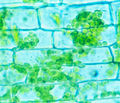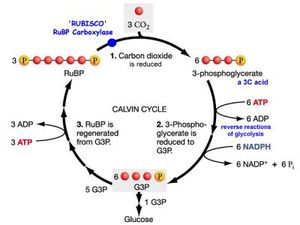Photosynthesis
This article gives an overview of the process called photosynthesis.
Introduction
Photosynthesis is the transformation of light energy into chemical energy for use in living cells. The overall process can be described as:
[math]CO_2 + 2 H_2O \rightarrow (CH_2O)_n + H_2O + O_2[/math]
With the aid of light and plants, water is split into hydrogen and oxygen. Carbohydrates ([math]CH_2O[/math]) such as sugars and starches are produced.
In plants, photosynthesis occurs in the chloroplasts. These are cell organelles bounded by a double membrane. Within these chloroplasts is a membrane system where light is captured and transformed into chemical energy, through the reaction of carbon dioxide ([math]CO_2[/math]) and water ([math]H_2O[/math]). The membranes are surrounded by spaces where this energy is used to produce the carbohydrates.
Chloroplasts [1]
Light energy is captured by photosynthetic pigments. All plants have chlorophyll a, which absorbs light energy most efficiently in the blue and green regions of the visible light spectrum.
Other pigments also absorb light, but in the parts of the light spectrum where chlorophyll a is relatively inefficient. These kind of pigments are called accessory pigments.
The whole process of photosynthesis is divided into the light reactions and the Calvin cycle. The light reactions capture the light energy. This is done by two reactions. The first one is that light energy is used in conjunction with a complex series of reactions to oxidize water and to split it. This produces molecular oxygen, protons ([math]H^+[/math]) and electrons ([math]e^-[/math]).
The electrons are transported by a chain of reactions and the in two distinct biochemical photosystems. The electrons then help ADP to convert into ATP, the major source of energy for the Calvin cycle. Next to this, electrons reduce NADP to NADPH, a major source of chemical reducing power in the Calvin cycle.
In the Calvin cycle, carbon is fixed to carbohydrates.
The overall reaction is:
The enzyme ribulose biphosphate carboxylase or Rubisco enables the reaction of carbon dioxide, water and the sugar ribulose biphosphate ([math]C_5[/math]) to produce a [math]C_3[/math] molecule. This [math]C_3[/math] molecule is the precursor of the [math]C_6[/math] sugars. ATP and NADPH are both required to make the reaction possible. Rubisco is generally regenerated from most of the reaction series. [2]
References
- ↑ http://en.wikipedia.org/wiki/Chloroplast
- ↑ Levinton J.S. 2001. Marine biology: function, biodiversity, ecology. Oxford University Press. p. 515
Please note that others may also have edited the contents of this article.
|



